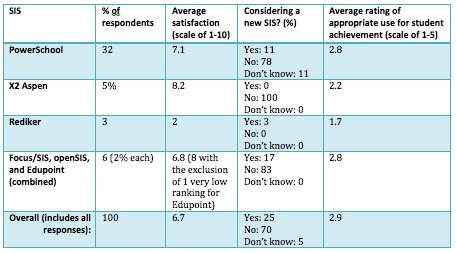The Great SIS Survey: Followup and wrapup

The Great SIS Survey has been sitting online for a while and, despite some of the usability issues readers have identified, has actually garnered 117 responses with quite a range of answers. Just to begin, one reader called me out on my omission of Moodle. It's worth noting that the line between SISs (Student Information Systems) and LMSs (Learning Management Systems) has blurred considerably. In particular, more SISs are adding learning management and virtual classroom features as they seek to become all-in-one learning solutions. However, Moodle is not an SIS. A school could conceivably use it as one, but it won't support the sort of reporting, family management, contact management, or student history that a full-blown SIS will.
That being said, let's take a look at the data. If we only examine the discrete measures (satisfaction, considering a switch, and how well the system is used) for the top 6 student information systems (actually the only systems with at least 2 responses), we can see a few trends (again, with a statistician's acknowledgement of small sample sizes, selection bias, and minimal statistical power - basically, we're talking anecdotal evidence here, but that's OK for our purposes).
Not unexpectedly, a whole lot of you are using PowerSchool. Pearson acquired PowerSchool from Apple in 2006 and has expanded its capabilities drastically. X2 Aspen's #2 ranking is most likely a result of my associations as a user and advisor with the SIS. A full 50% of respondents used an "Other" system, reflecting the sheer diversity in this market. 5% used what was classified as a custom system and it's worth noting that many large districts have implemented mainframe-based or more modern, highly complex custom systems, representing very large groups of users.
What can we take away from this? It's hard to judge the one poor performer (Rediker) from 3 responses. I've evaluated Rediker in detail before and was impressed by its lengthy feature set, speed, and general ease of use in key modules. That being said, the client-server architecture that enables such speed and a rich interface means that anytime/anywhere access is a bit harder to come by. It's also a collection of modules, somewhat loosely tied together, giving a rough user experience, despite some very well-designed components.
Open source is holding its own and a look at the major FOSS SISs shows incredibly mature web-based systems that can run virtually any school.
Comments on PowerSchool ranged from "Gradebook is horrible" to needs a "true SaaS infrastructure" with "integration with BI Tools" to praise for its reporting features. More than anything, the comments point to a need for training and professional development as well as truly advanced features that most proprietary SISs don't provide.
As many administrators know, all too often bad mojo around a school's SIS is the result of too little training and too little time to explore and master a system.
A few more pictures to give you some food for thought and visuals to go with the data summary:
Anyone else notice that the gradebook and reporting features will make or break an SIS?
One last aside. A couple of readers suggested that I use SISSurvey.net and that I collect more data, particularly related to school size. SIS Survey is indeed a slick tool and many other data fields would have made for a more comprehensive survey. My goal here was just to get a quick sense of how satisfied people were with the SIS with which they needed to interact every day and take a broad view of the best and worst features across a self-selected group of users. Hardly a scientific approach, but the message is clear even from these data: the SIS market needs some improving. SIS vendors, in fact, have a long way to go to meet the heterogeneous needs of educators. More than that, though, we as educators and administrators have a long way to go to properly train and empower the users of these systems.
